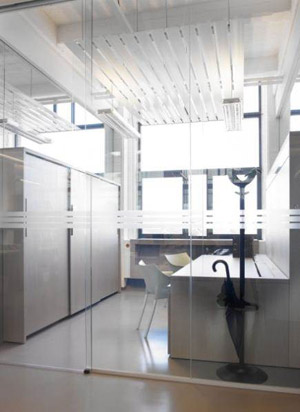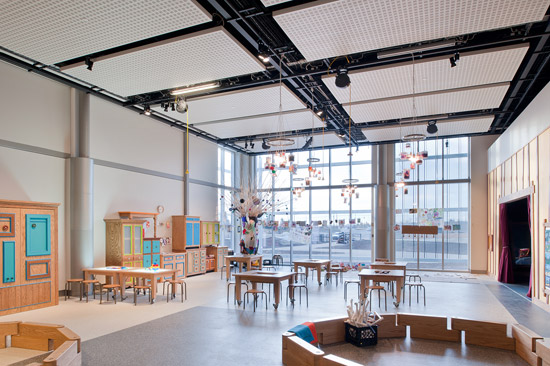Architects Warm to Chilled Ceilings
Hybrid HVAC at Upper Iowa University Helps Achieve LEED Silver |
||||
A USGBC LEED Silver designation for the building was targeted from the outset of the design process, with the design team specifying a cutting-edge hybrid HVAC system that incorporates both underfloor air distribution and chilled sails—the first of its kind in a U.S. college. Close collaboration between the design team, mechanical contractors, and the manufacturer was key to achieving core objectives of an HVAC system that would reduce operating costs, provide maximum comfort for students, and afford future flexibility as the utilization of the space evolved—all within a new building that fit with the historic feel of the 153-year-old campus. A hybrid underfloor air distribution and chilled sail solution was specified. Architectural firm Meyer, Scherer & Rockcastle, Ltd, (MS&R) and mechanical engineering firm Karges-Faulconbridge, Inc. (KFI) had successful experiences with underfloor air distribution systems in the past, and were intrigued by the additional benefits of incorporating chilled sails into a hybrid solution. The underfloor component of the hybrid system ventilates the building with fresh air, while the chilled sail component delivers radiant heating and cooling to classrooms, offices, and the auditorium. Underfloor air distribution is renowned for the flexibility it brings to evolving spaces, as it uses an easily reconfigured raised floor tile system and underfloor air plenum. The underfloor displacement diffusers deliver high indoor air quality, as air in the space is thermally stratified and contaminants move up and out of the breathing zone, rather than being recirculated. Chilled sails, which provide both a radiant and convective component, use water to efficiently condition the space. Convection currents are created when warm air is cooled as it passes over the surface of the sail. This cooled air then naturally falls into the occupied zone, forcing warm air to rise.
Chilled sails rely on the underfloor air distribution system to provide fresh air for ventilation, which greatly reduces the supply air volume requirement and makes the system extremely energy efficient. Due to their aesthetically pleasing appearance, chilled sails also fit extremely well into the architect’s design vision for the building, making them both an architectural element and an HVAC system component. The raised-floor plenum used in the underfloor air distribution system is substantially smaller than the suspended ceiling necessary for an overhead system. This reduced construction costs and ensured a floor-to-floor height that was in line with other facilities on campus. Executive Director of Facilities, Bryan Jolley, states that the building has already played an important role in illustrating design concepts and demonstrating to prospective students the ways in which sustainable design goals on the campus are being met. |
Profiles and Finish Options
Modular panels can be easily installed in an exposed grid acoustical ceiling system and can be laid into traditional T-Bar systems. When used across an entire floorplate, it is common to use spring clips to suspend the radiant panels from a concealed structure. This tends to improve the look as well as functionality in that the panels offer easy access to the space above, hinging when connected with flexible hosing to access any areas above the ceiling. For these applications, perforated panels are typically used in order to offer acoustical attenuation, as well as cooling and/or heating to the zone below.
Radiant panels can be freely suspended when an open ceiling effect is desired, as is common with converted warehouses, schools, etc., or in spaces where the ceilings would be otherwise too high for radiation to be an effective method of heating and cooling. These panels feature integral structure, trim on the edges, as well as concealed fastening.
A range of surface finishes are available including anodized aluminum, silk screening, to match an acoustical tile, for example, as well as perforated or formed metal pieces. While manufacturers offer an extensive range of profiles and finishes, many architects gravitate toward custom solutions rather than cataloged options as there is a lot of flexibility in the construction of the chilled ceiling.
Condensation
A common concern with hydronic radiant cooling systems is the potential for condensation. Proper planning and control can make this a non-issue. To avoid condensation and its effects, radiant ceilings must be maintained several degrees warmer than the dewpoint. This requires that ventilation air be used to control the space latent loads. This ventilation air is often dehumidified via a parallel system to decouple the space sensible and latent loads. The use of an additional system, such as a dehumidifier or dedicated outdoor air system (DOAS), can both control space humidity and allow for increased cooling capacity by the ventilation air. It is important that the dewpoint temperature be determined with some precision and circulating water temperature controlled to achieve effective cooling while avoiding condensation. Today's advanced sensors and controls enable fast, accurate tracking and adjusting to optimize the cooling function while avoiding condensation problems.
When properly ventilated, radiant cooling systems show distinct energy savings. Corina Stetiu of Lawrence Berkeley National Laboratory developed detailed simulations of a prototypical office building in nine U.S. cities to compare the performance of radiant cooling systems with ventilation and conventional all-air systems.1 Stetiu found that, on average, radiant cooling systems save 30 percent on overall energy for cooling and 27 percent on demand vs. their all-air counterparts.
Energy savings ranged from 17 percent in cold, moist areas to 42 percent in warmer, dry areas, with the humid areas showing lower savings because of the costs associated with required dehumidification.
Significant Energy Savings from Innovative Mechanical System at TELUS Spark: The New Science Centre |
||
In the new Calgary Science Centre, which doubles the capacity of the existing facility, and hosts up to 500,000 visitors each year, Calgary design firm DIALOG specified an innovative mechanical system that has achieved an energy savings of 44 percent lower than the ASHRAE 90.1-1999 baseline. In addition to a high-performance building envelope designed to reduce mechanical ventilation system operating cost, space cooling and heating requirements were decoupled from the ventilation system, yielding enhanced energy performance, thermal comfort, and indoor air quality. Generally all areas are ventilated, and partially cooled, by a displacement ventilation system, which introduces supply air at or near the floor level, at a low velocity, and at a temperature only slightly below the desired room temperature. The cooler supply air “displaces” the warmer room air, creating a zone of fresh cool air at the occupied level. Heat, moisture, and contaminants produced by activities in the space rise with the air to the ceiling level and are exhausted from the space. Perimeter radiant heating panels were used to manage glazing loads and envelope losses throughout the perimeter spaces. Radiant cooling panels were incorporated into the majority of occupied spaces to augment cooling from the demand controlled displacement ventilation system. In the various galleries, floating clouds of perforated radiant cooling panels create a well-integrated, finished acoustic ceiling plane. Office areas utilize perforated acoustic panels in a lay-in acoustic ceiling. Finally, the central atrium uses radiant chilled/heated slabs and displacement ventilation, creating a mechanical system which is inconspicuous but highly effective. In operation, the hybrid mechanical system has proven its energy-saving ability, its draft-free thermal comfort, greater ventilation effectiveness, and superior acoustics. The building received the Alberta Construction Magazine Top Award, Institutional Category and the Canadian Institute of Steel Construction 2013 Alberta Steel Design, Architecture Award of Excellence.
|












